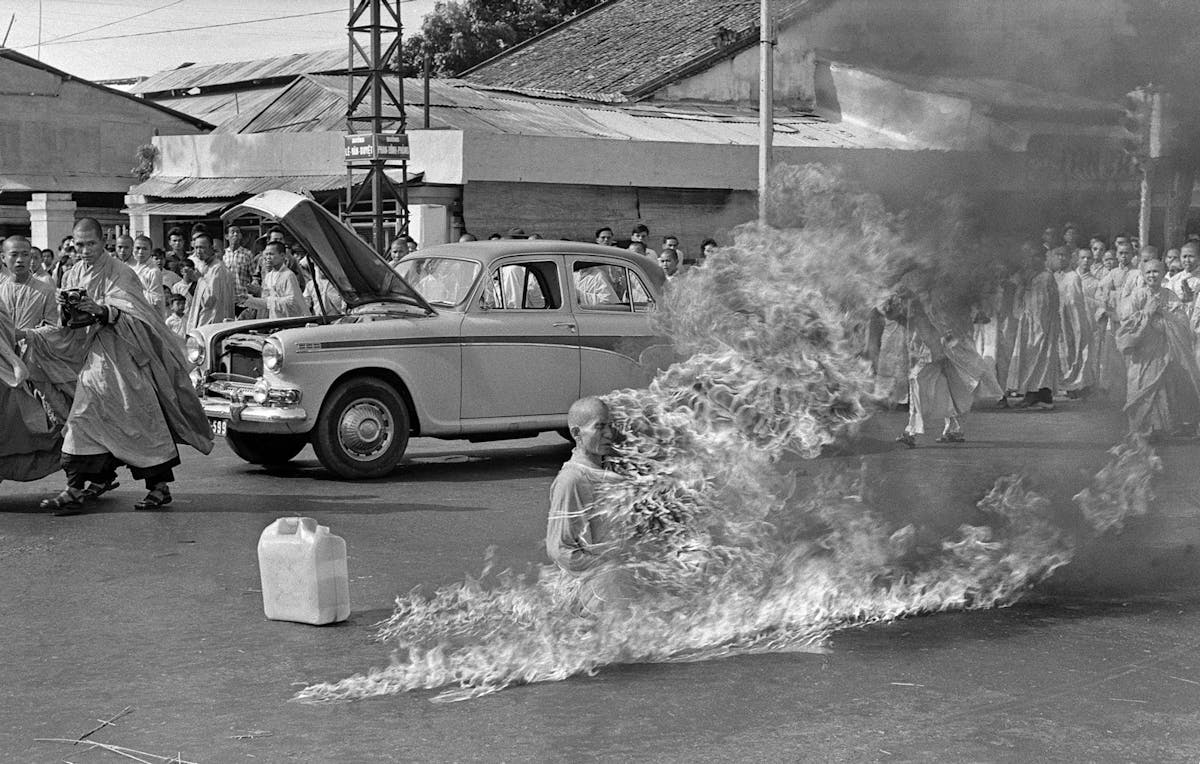On the Ground With a Pulitzer Winner, Malcolm Browne, in South Vietnam
The modest Browne is perhaps the ideal subject to show how a dedication to journalism — to getting the story — would naturally alienate the reporter from supporters of government policy.

‘The Ultimate Protest: Malcolm W. Browne, Thich Quang Duc, and the News Photograph That Stunned the World’
By Ray E. Boomhower
High Road Books, 344 pages
On June 1, 1963, a Buddhist monk, Thich Quang Duc, had himself set on fire by his fellow monks, determined that his death might command the world’s attention to the persecution of Buddhists by the Catholic-dominated government of South Vietnam’s president, Ngo Dinh Diem’s.
An Associated Press correspondent, Malcolm W. Browne, was the only Western newsman to get close enough to take a photograph of the dying monk. In 1964, Browne won a Pulitzer Prize for his reporting from South Vietnam, but he also provoked the enmity of American and South Vietnamese officials, as well as American journalists of the World War II era, who regarded the new generation of war correspondents as biased against the American effort to save the country from becoming part of the Soviet/Sino orbit.
The author of several books on American war correspondents, including “Richard Tregaskis: Reporting Under Fire From Guadalcanal to Vietnam” and “Dispatches from the Pacific: The World War II Reporting of Robert E. Sherrod,” Ray Boomhower continues a masterful history of a press corps schooled to believe in the rightness of American foreign policy that required opposition to the aggressive post-war communist takeover of countries in Europe and Asia.
Browne believed that those older correspondents were not willing to see the war in Vietnam as it was actually happening on the ground, which meant they discounted reports of American indiscriminate bombing, say, and the corruption of the Diem government that increasingly sheltered him from the suffering of the Vietnamese in their vulnerable villages, caught between the firefights of opposing sides without a battlefield.
Despite differences with the earlier generation of war correspondents, Browne was like most of them in not wishing to make his personality and opinions the story. He wanted to report what he actually saw, which is why his photograph of the monk was so powerful. That picture of a man on fire in protest against his government had only been possible to capture because of Browne’s on-the-ground affinity for the people of Vietnam and his proximity to their agony.
If Browne is not as famous as other reporters of his generation, that is partly due to his low-key temperament, which never allowed him to grandstand, and to his loyalty to print journalism. He tried to work for ABC television and found the network’s reporting superficial and too inclined to turn the news into a show, with Browne getting advice on how to apply pancake makeup.
Browne also tried fiction, which other correspondents successfully pursued and that enhanced their public profiles. Nothing came, though, of Browne’s novels. Exactly why, Mr. Boomhower does not say, but it seems that Browne could not go beyond reporting what he had observed.
Through Browne, we see an American officialdom, in South Vietnam and Washington, unprepared to investigate the reports of Browne and other young correspondents that the war was not going well for the anti-communist forces. The South Vietnamese government never seemed able to tolerate press criticism, and actively engaged in efforts to intimidate and even physically harm journalists.
The modest Browne is perhaps the ideal subject to show how a dedication to journalism — to getting the story — would naturally alienate the reporter from supporters of government policy. Yet no matter how badly Browne was treated by South Vietnamese and American officials, he never seems to have resented them. All that mattered to him, again, was the story, not the character of those who prevented him from getting it.
Browne continued his career after the war ended and resumed his earlier interest in writing about science. He published a well-received memoir of his career as a journalist. At 60 he covered the first Gulf war, sadly realizing that relations between the press and the American government had not materially improved, though the government’s skill at manipulating the press had become better.
Mr. Rollyson is the author of “Nothing Ever Happens to the Brave: The Adventures of America’s Most Glamorous and Courageous War Correspondent, The Story of Martha Gellhorn.”

